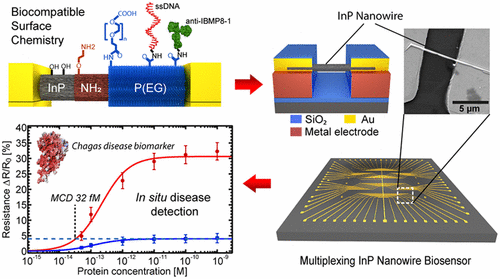当前位置:
X-MOL 学术
›
Nano Lett.
›
论文详情
Our official English website, www.x-mol.net, welcomes your
feedback! (Note: you will need to create a separate account there.)
InP Nanowire Biosensor with Tailored Biofunctionalization: Ultrasensitive and Highly Selective Disease Biomarker Detection
Nano Letters ( IF 9.6 ) Pub Date : 2017-09-19 00:00:00 , DOI: 10.1021/acs.nanolett.7b01803 Richard Janissen 1, 2 , Prasana K. Sahoo 1 , Clelton A. Santos 3 , Aldeliane M. da Silva 1 , Antonio A. G. von Zuben 1 , Denio E. P. Souto 4 , Alexandre D. T. Costa 5 , Paola Celedon 6 , Nilson I. T. Zanchin 5 , Diogo B. Almeida 1 , Douglas S. Oliveira 1 , Lauro T. Kubota 4 , Carlos L. Cesar 1 , Anete P. de Souza 3 , Monica A. Cotta 1
Nano Letters ( IF 9.6 ) Pub Date : 2017-09-19 00:00:00 , DOI: 10.1021/acs.nanolett.7b01803 Richard Janissen 1, 2 , Prasana K. Sahoo 1 , Clelton A. Santos 3 , Aldeliane M. da Silva 1 , Antonio A. G. von Zuben 1 , Denio E. P. Souto 4 , Alexandre D. T. Costa 5 , Paola Celedon 6 , Nilson I. T. Zanchin 5 , Diogo B. Almeida 1 , Douglas S. Oliveira 1 , Lauro T. Kubota 4 , Carlos L. Cesar 1 , Anete P. de Souza 3 , Monica A. Cotta 1
Affiliation

|
Electrically active field-effect transistors (FET) based biosensors are of paramount importance in life science applications, as they offer direct, fast, and highly sensitive label-free detection capabilities of several biomolecules of specific interest. In this work, we report a detailed investigation on surface functionalization and covalent immobilization of biomarkers using biocompatible ethanolamine and poly(ethylene glycol) derivate coatings, as compared to the conventional approaches using silica monoliths, in order to substantially increase both the sensitivity and molecular selectivity of nanowire-based FET biosensor platforms. Quantitative fluorescence, atomic and Kelvin probe force microscopy allowed detailed investigation of the homogeneity and density of immobilized biomarkers on different biofunctionalized surfaces. Significantly enhanced binding specificity, biomarker density, and target biomolecule capture efficiency were thus achieved for DNA as well as for proteins from pathogens. This optimized functionalization methodology was applied to InP nanowires that due to their low surface recombination rates were used as new active transducers for biosensors. The developed devices provide ultrahigh label-free detection sensitivities ∼1 fM for specific DNA sequences, measured via the net change in device electrical resistance. Similar levels of ultrasensitive detection of ∼6 fM were achieved for a Chagas Disease protein marker (IBMP8-1). The developed InP nanowire biosensor provides thus a qualified tool for detection of the chronic infection stage of this disease, leading to improved diagnosis and control of spread. These methodological developments are expected to substantially enhance the chemical robustness, diagnostic reliability, detection sensitivity, and biomarker selectivity for current and future biosensing devices.
中文翻译:

具有量身定制的生物功能化的InP纳米线生物传感器:超灵敏和高度选择性的疾病生物标志物检测
基于电活性场效应晶体管(FET)的生物传感器在生命科学应用中至关重要,因为它们提供了直接,快速和高度灵敏的无标记的多种感兴趣的生物分子检测功能。在这项工作中,我们报告了使用生物相容性乙醇胺和聚乙二醇衍生物涂层对生物标志物进行表面功能化和共价固定化的详细研究,与使用二氧化硅整体法的常规方法相比,以大大提高灵敏度和分子选择性基于纳米线的FET生物传感器平台。定量荧光,原子和开尔文探针力显微镜可以对固定在不同生物功能化表面上的生物标志物的均质性和密度进行详细研究。因此,DNA以及病原体蛋白质的结合特异性,生物标志物密度和目标生物分子捕获效率均得到显着提高。这种优化的功能化方法已应用于InP纳米线,由于它们的低表面重组率,它们被用作生物传感器的新型有源换能器。通过设备电阻的净变化测量,开发的设备可为特定的DNA序列提供1fM的超高无标记检测灵敏度。Chagas病蛋白标记(IBMP8-1)达到了类似的〜6 fM的超灵敏检测水平。因此,已开发的InP纳米线生物传感器为检测这种疾病的慢性感染阶段提供了合格的工具,从而改善了传播的诊断和控制。
更新日期:2017-09-19
中文翻译:

具有量身定制的生物功能化的InP纳米线生物传感器:超灵敏和高度选择性的疾病生物标志物检测
基于电活性场效应晶体管(FET)的生物传感器在生命科学应用中至关重要,因为它们提供了直接,快速和高度灵敏的无标记的多种感兴趣的生物分子检测功能。在这项工作中,我们报告了使用生物相容性乙醇胺和聚乙二醇衍生物涂层对生物标志物进行表面功能化和共价固定化的详细研究,与使用二氧化硅整体法的常规方法相比,以大大提高灵敏度和分子选择性基于纳米线的FET生物传感器平台。定量荧光,原子和开尔文探针力显微镜可以对固定在不同生物功能化表面上的生物标志物的均质性和密度进行详细研究。因此,DNA以及病原体蛋白质的结合特异性,生物标志物密度和目标生物分子捕获效率均得到显着提高。这种优化的功能化方法已应用于InP纳米线,由于它们的低表面重组率,它们被用作生物传感器的新型有源换能器。通过设备电阻的净变化测量,开发的设备可为特定的DNA序列提供1fM的超高无标记检测灵敏度。Chagas病蛋白标记(IBMP8-1)达到了类似的〜6 fM的超灵敏检测水平。因此,已开发的InP纳米线生物传感器为检测这种疾病的慢性感染阶段提供了合格的工具,从而改善了传播的诊断和控制。









































 京公网安备 11010802027423号
京公网安备 11010802027423号